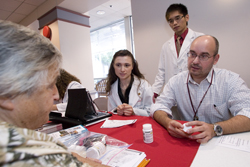Mixing meds: A recipe for disaster
|
When an 83-year-old woman was admitted to the hospital because she was falling down and feeling disoriented, a close look at her medications revealed the culprit to be polypharmacy.
Or, a certain ingredient reaches a toxic level and causes complications, such as bleeding, or even death. The risk of such consequences is 5 percent when taking three drugs and shoots to 50 percent when taking six or more drugs. |
|
|
Polypharmacy can be intentional or accidental.
Elderly most at risk |
Temple performs medication checkups On Aug. 12, pharmacists and students from Temple's School of Pharmacy performed medication checkups at Jeanes Hospital. They were looking for potential drug interactions that can result from polypharmacy — taking multiple medications simultaneously. The School of Pharmacy and Jeanes Hospital will offer another medication
Photos by Ryan S. Brandenberg/Temple University
Sister Paulette Elking, (right) a retired pharmacist, takes 34 different medications for asthma and osteoarthritis, among other ailments. She consulted with Melissa Ranieri, (left) Pharm.D, of Temple's School of Pharmacy, and Tung Vu, (right) a fourth-year pharmacy student, about polypharmacy risks, but reported no troubling side effects from her |
|
“As our bodies age, the functions that help metabolize and excrete drugs are diminished,” said McDonnell. “We also suffer decreased cognitive function and make inadvertent mistakes with our meds.”
|
|

